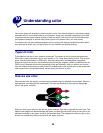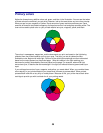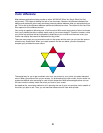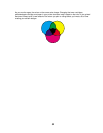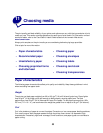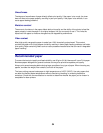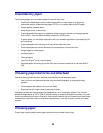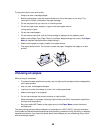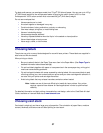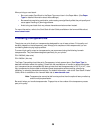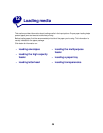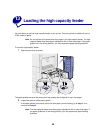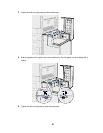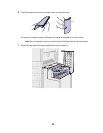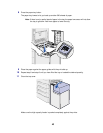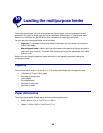
37
For best performance, use envelopes made from 75 g/m
2
(20 lb bond) paper. You can use up to 105 g/
m
2
(28 lb bond) weight for the multipurpose feeder as long as the cotton content is 25% or less.
Envelopes with 100% cotton content must not exceed 90 g/m
2
(24 lb bond) weight.
Do not use envelopes that:
• Have excessive curl or twist
• Are stuck together or damaged in any way
• Contain windows, holes, perforations, cutouts, or embossing
• Use metal clasps, string ties, or metal folding bars
• Have an interlocking design
• Have postage stamps attached
• Have any exposed adhesive when the flap is in the sealed or closed position
• Have nicked edges or bent corners
• Have rough, cockle, or laid finishes
Choosing labels
The printer can print on many labels designed for use with laser printers. These labels are supplied in
letter size and A4 size sheets.
When printing on labels:
• Be sure to select Labels in the Paper Type menu item in the Paper Menu. (See Paper Type for
detailed information about these settings.)
• Do not load labels together with paper or transparencies in the same paper tray; mixing print
media can cause feeding problems.
• Do not load partial sheets with areas exposed by missing labels; this can cause labels to peel
off during printing, jam, and contaminate your printer and your toner cartridge with adhesive. It
can also void your printer and cartridge warranties.
• Avoid using labels that may release hazardous emissions when heated.
Note: Labels are one of the most difficult print media for laser printers. Your printer
requires a special fuser cleaner for label applications in order to optimize feed
reliability.
For detailed information on label printing, characteristics, and design, refer to the Card Stock & Label
Guide, available on Lexmark Web site at www.lexmark.com.
Choosing card stock
Card stock is single-ply and has a large array of properties. The orientation of paper fibers, moisture
content, thickness, and texture can all affect printing on card stock.



